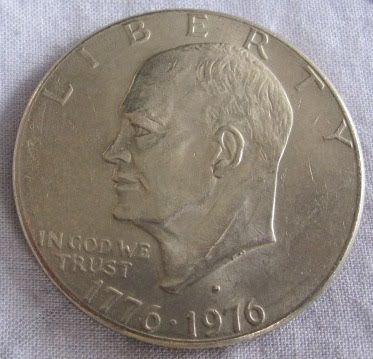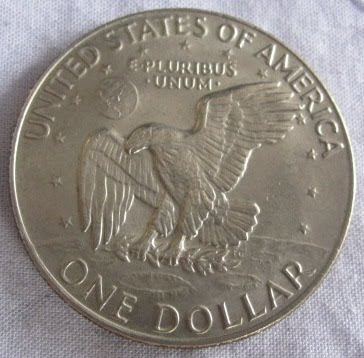Liberty bell, Philadelphia

Eisenhower bicentennial dollar, 1976


Released on the bicentennial of the independence of the USA i.e. in 1976, this dollar has president Eisenhower on the obverse and the liberty bell and moon on the reverse.
Tradition tells of a chime that changed the world on July 8, 1776, with the Liberty Bell ringing out from the tower of Independence Hall summoning the citizens of Philadelphia to hear the first public reading of the Declaration of Independence by Colonel John Nixon.
The Pennsylvania Assembly ordered the Bell in 1751 to commemorate the 50-year anniversary of William Penn's 1701 Charter of Privileges, Pennsylvania's original Constitution. It speaks of the rights and freedoms valued by people the world over. Particularly forward thinking were Penn's ideas on religious freedom, his liberal stance on Native American rights, and his inclusion of citizens in enacting laws.
The Liberty Bell gained iconic importance when abolitionists in their efforts to put an end to slavery throughout America adopted it as a symbol.
There is widespread disagreement about when the first crack appeared on the Bell. Hair-line cracks on bells were bored out to prevent expansion. However, it is agreed that the final expansion of the crack which rendered the Bell unringable was on Washington's Birthday in 1846.
The bell had also been rung to announce the opening of the First Continental Congress in 1774 and after the Battle of Lexington and Concord in 1775.
The Liberty Bell was known as the "Independence Bell" or the "Old Yankee's Bell" until 1837, when it was adopted by the American Anti-Slavery Society as a symbol of the abolitionist movement.
Eisenhower dollar, 1978

 The Eisenhower 1 dollar was minted for an 8 year period from 1971-1978 and is named for president Dwight David Eisenhower, who appears on the obverse. It followed the Peace dollar program and was the last dollar in circulation to have a proportional amount of base metal. It has the same amount of metal as two Kennedy half dollars, four Washington quarters or ten Roosevelt dimes. It was rarely used for circulation as it was too large and cumbersome, and was replaced by the even less popular Susan Anthony dollar in 1979. The design on the reverse is the Apollo 11 insignia, which is an eagle landing on the moon with the Earth showing in the background. This design was continued on the dollar coins even after the Eisenhower was no longer minted, although in a shrunken form. The Apollo insignia continued to be on the dollar coin until the introduction of the Sacagaewa dollar.
The Eisenhower 1 dollar was minted for an 8 year period from 1971-1978 and is named for president Dwight David Eisenhower, who appears on the obverse. It followed the Peace dollar program and was the last dollar in circulation to have a proportional amount of base metal. It has the same amount of metal as two Kennedy half dollars, four Washington quarters or ten Roosevelt dimes. It was rarely used for circulation as it was too large and cumbersome, and was replaced by the even less popular Susan Anthony dollar in 1979. The design on the reverse is the Apollo 11 insignia, which is an eagle landing on the moon with the Earth showing in the background. This design was continued on the dollar coins even after the Eisenhower was no longer minted, although in a shrunken form. The Apollo insignia continued to be on the dollar coin until the introduction of the Sacagaewa dollar.The Eisenhower dollars are huge coins having a diameter of 38.1 mm and the weight is 22.68gm.
Born in Texas in 1890, brought up in Abilene, Kansas, Eisenhower was the third of seven sons. He excelled in sports in high school, and received an appointment to West Point. Stationed in Texas as a second lieutenant, he met Mamie Geneva Doud, whom he married in 1916.
In his early Army career, he excelled in staff assignments, serving under Generals John J. Pershing, Douglas MacArthur, and Walter Krueger. After Pearl Harbor, General George C. Marshall called him to Washington for a war plans assignment. He commanded the Allied Forces landing in North Africa in November 1942; on D-Day, 1944, he was Supreme Commander of the troops invading France.
After the war, he became President of Columbia University, then took leave to assume supreme command over the new NATO forces being assembled in 1951. Republican emissaries to his headquarters near Paris persuaded him to run for President in 1952.
"I like Ike" was an irresistible slogan; Eisenhower won a sweeping victory.
In September 1955, Eisenhower suffered a heart attack in Denver, Colorado. After seven weeks he left the hospital, and in February 1956 doctors reported his recovery. In November he was elected for his second term.
In domestic policy the President pursued a middle course, continuing most of the New Deal and Fair Deal programs, emphasizing a balanced budget. As desegregation of schools began, he sent troops into Little Rock, Arkansas, to assure compliance with the orders of a Federal court; he also ordered the complete desegregation of the Armed Forces. "There must be no second class citizens in this country," he wrote.
Eisenhower concentrated on maintaining world peace. He watched with pleasure the development of his "atoms for peace" program--the loan of American uranium to "have not" nations for peaceful purposes.
Before he left office in January 1961, for his farm in Gettysburg, he urged the necessity of maintaining an adequate military strength, but cautioned that vast, long-continued military expenditures could breed potential dangers to our way of life. He concluded with a prayer for peace "in the goodness of time." Both themes remained timely and urgent when he died, after a long illness, on March 28, 1969.



No comments:
Post a Comment